Construction and Building law PDF
VerifiedAdded on 2021/06/14
|11
|2163
|186
AI Summary
Contribute Materials
Your contribution can guide someone’s learning journey. Share your
documents today.
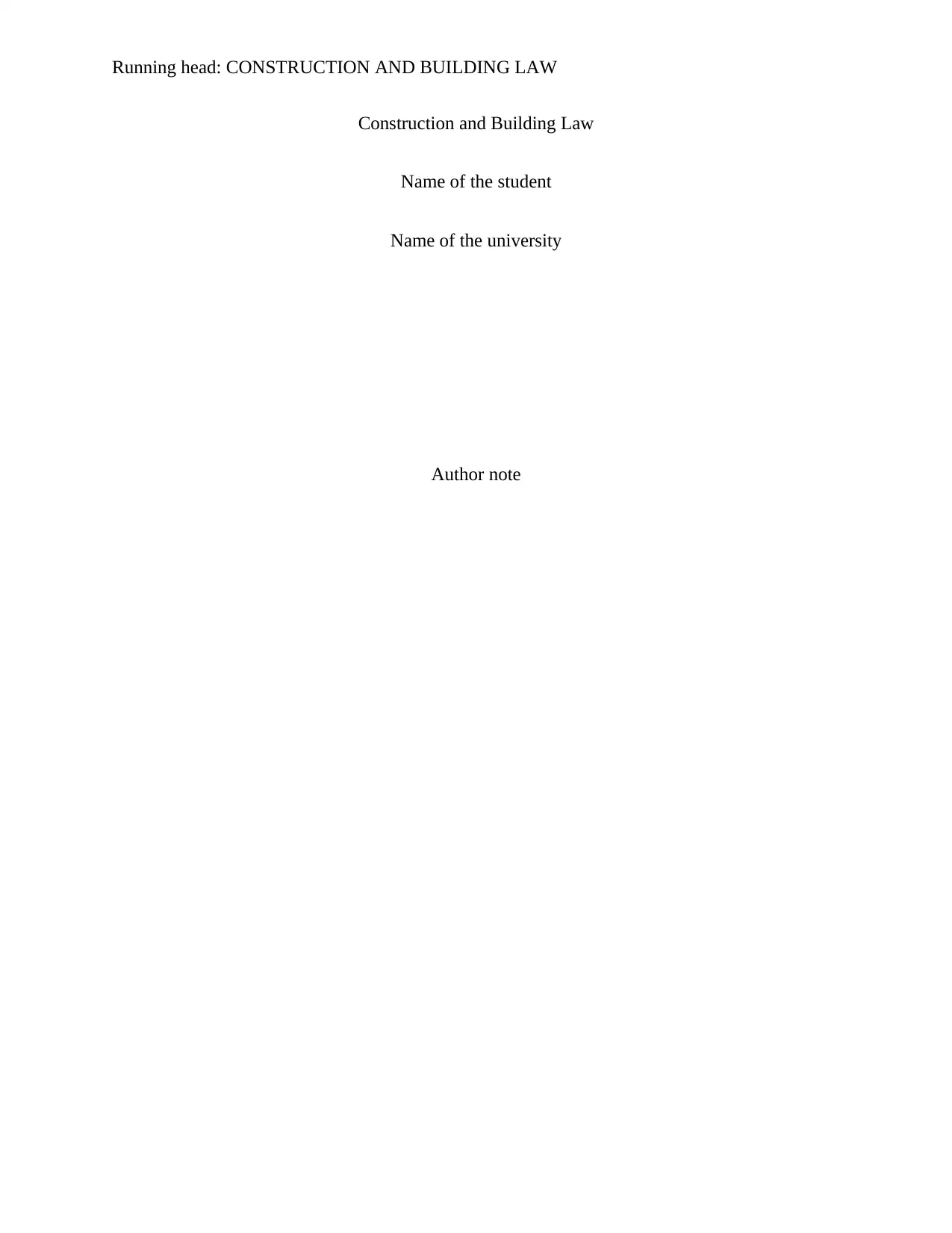
Running head: CONSTRUCTION AND BUILDING LAW
Construction and Building Law
Name of the student
Name of the university
Author note
Construction and Building Law
Name of the student
Name of the university
Author note
Secure Best Marks with AI Grader
Need help grading? Try our AI Grader for instant feedback on your assignments.
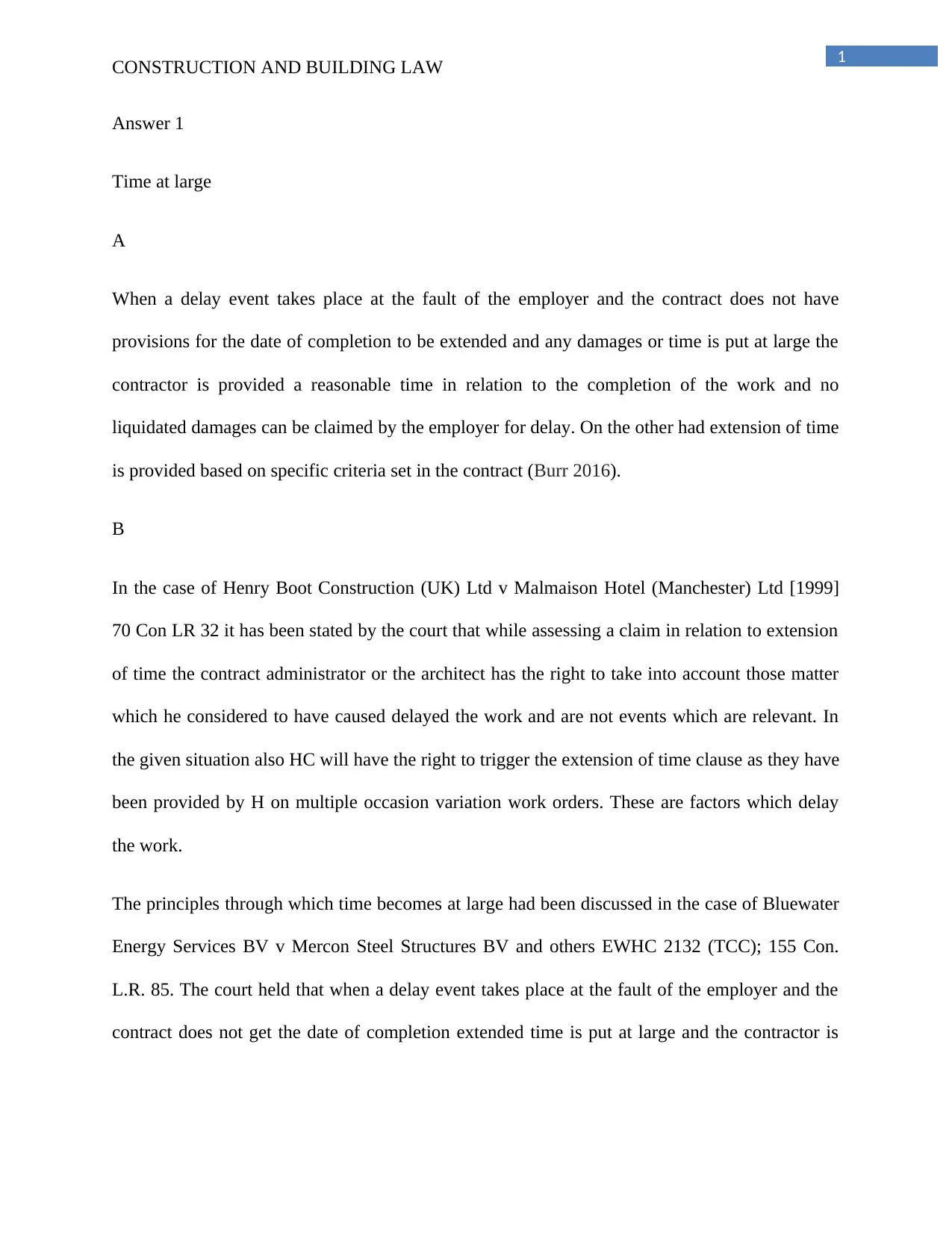
1
CONSTRUCTION AND BUILDING LAW
Answer 1
Time at large
A
When a delay event takes place at the fault of the employer and the contract does not have
provisions for the date of completion to be extended and any damages or time is put at large the
contractor is provided a reasonable time in relation to the completion of the work and no
liquidated damages can be claimed by the employer for delay. On the other had extension of time
is provided based on specific criteria set in the contract (Burr 2016).
B
In the case of Henry Boot Construction (UK) Ltd v Malmaison Hotel (Manchester) Ltd [1999]
70 Con LR 32 it has been stated by the court that while assessing a claim in relation to extension
of time the contract administrator or the architect has the right to take into account those matter
which he considered to have caused delayed the work and are not events which are relevant. In
the given situation also HC will have the right to trigger the extension of time clause as they have
been provided by H on multiple occasion variation work orders. These are factors which delay
the work.
The principles through which time becomes at large had been discussed in the case of Bluewater
Energy Services BV v Mercon Steel Structures BV and others EWHC 2132 (TCC); 155 Con.
L.R. 85. The court held that when a delay event takes place at the fault of the employer and the
contract does not get the date of completion extended time is put at large and the contractor is
CONSTRUCTION AND BUILDING LAW
Answer 1
Time at large
A
When a delay event takes place at the fault of the employer and the contract does not have
provisions for the date of completion to be extended and any damages or time is put at large the
contractor is provided a reasonable time in relation to the completion of the work and no
liquidated damages can be claimed by the employer for delay. On the other had extension of time
is provided based on specific criteria set in the contract (Burr 2016).
B
In the case of Henry Boot Construction (UK) Ltd v Malmaison Hotel (Manchester) Ltd [1999]
70 Con LR 32 it has been stated by the court that while assessing a claim in relation to extension
of time the contract administrator or the architect has the right to take into account those matter
which he considered to have caused delayed the work and are not events which are relevant. In
the given situation also HC will have the right to trigger the extension of time clause as they have
been provided by H on multiple occasion variation work orders. These are factors which delay
the work.
The principles through which time becomes at large had been discussed in the case of Bluewater
Energy Services BV v Mercon Steel Structures BV and others EWHC 2132 (TCC); 155 Con.
L.R. 85. The court held that when a delay event takes place at the fault of the employer and the
contract does not get the date of completion extended time is put at large and the contractor is
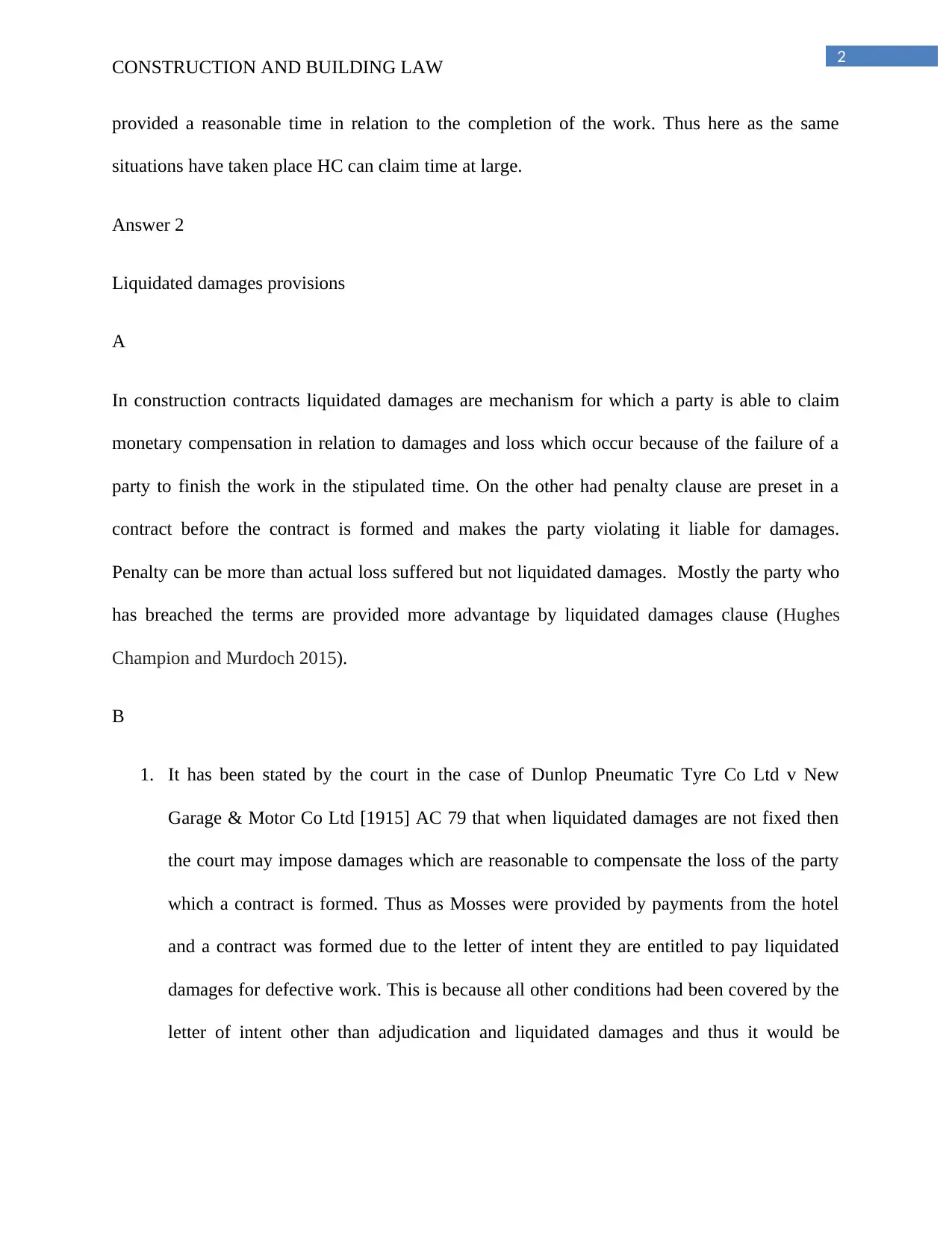
2
CONSTRUCTION AND BUILDING LAW
provided a reasonable time in relation to the completion of the work. Thus here as the same
situations have taken place HC can claim time at large.
Answer 2
Liquidated damages provisions
A
In construction contracts liquidated damages are mechanism for which a party is able to claim
monetary compensation in relation to damages and loss which occur because of the failure of a
party to finish the work in the stipulated time. On the other had penalty clause are preset in a
contract before the contract is formed and makes the party violating it liable for damages.
Penalty can be more than actual loss suffered but not liquidated damages. Mostly the party who
has breached the terms are provided more advantage by liquidated damages clause (Hughes
Champion and Murdoch 2015).
B
1. It has been stated by the court in the case of Dunlop Pneumatic Tyre Co Ltd v New
Garage & Motor Co Ltd [1915] AC 79 that when liquidated damages are not fixed then
the court may impose damages which are reasonable to compensate the loss of the party
which a contract is formed. Thus as Mosses were provided by payments from the hotel
and a contract was formed due to the letter of intent they are entitled to pay liquidated
damages for defective work. This is because all other conditions had been covered by the
letter of intent other than adjudication and liquidated damages and thus it would be
CONSTRUCTION AND BUILDING LAW
provided a reasonable time in relation to the completion of the work. Thus here as the same
situations have taken place HC can claim time at large.
Answer 2
Liquidated damages provisions
A
In construction contracts liquidated damages are mechanism for which a party is able to claim
monetary compensation in relation to damages and loss which occur because of the failure of a
party to finish the work in the stipulated time. On the other had penalty clause are preset in a
contract before the contract is formed and makes the party violating it liable for damages.
Penalty can be more than actual loss suffered but not liquidated damages. Mostly the party who
has breached the terms are provided more advantage by liquidated damages clause (Hughes
Champion and Murdoch 2015).
B
1. It has been stated by the court in the case of Dunlop Pneumatic Tyre Co Ltd v New
Garage & Motor Co Ltd [1915] AC 79 that when liquidated damages are not fixed then
the court may impose damages which are reasonable to compensate the loss of the party
which a contract is formed. Thus as Mosses were provided by payments from the hotel
and a contract was formed due to the letter of intent they are entitled to pay liquidated
damages for defective work. This is because all other conditions had been covered by the
letter of intent other than adjudication and liquidated damages and thus it would be
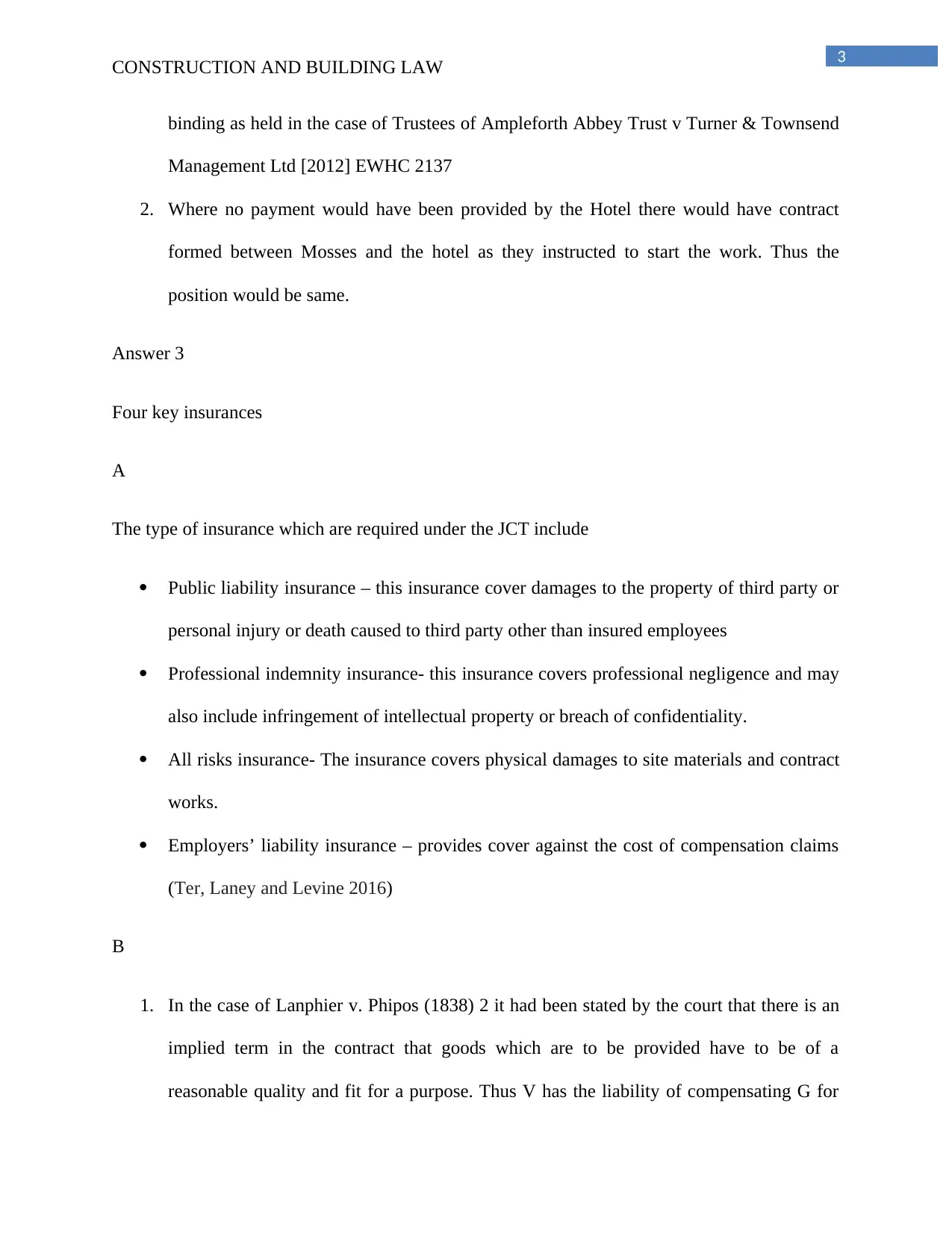
3
CONSTRUCTION AND BUILDING LAW
binding as held in the case of Trustees of Ampleforth Abbey Trust v Turner & Townsend
Management Ltd [2012] EWHC 2137
2. Where no payment would have been provided by the Hotel there would have contract
formed between Mosses and the hotel as they instructed to start the work. Thus the
position would be same.
Answer 3
Four key insurances
A
The type of insurance which are required under the JCT include
Public liability insurance – this insurance cover damages to the property of third party or
personal injury or death caused to third party other than insured employees
Professional indemnity insurance- this insurance covers professional negligence and may
also include infringement of intellectual property or breach of confidentiality.
All risks insurance- The insurance covers physical damages to site materials and contract
works.
Employers’ liability insurance – provides cover against the cost of compensation claims
(Ter, Laney and Levine 2016)
B
1. In the case of Lanphier v. Phipos (1838) 2 it had been stated by the court that there is an
implied term in the contract that goods which are to be provided have to be of a
reasonable quality and fit for a purpose. Thus V has the liability of compensating G for
CONSTRUCTION AND BUILDING LAW
binding as held in the case of Trustees of Ampleforth Abbey Trust v Turner & Townsend
Management Ltd [2012] EWHC 2137
2. Where no payment would have been provided by the Hotel there would have contract
formed between Mosses and the hotel as they instructed to start the work. Thus the
position would be same.
Answer 3
Four key insurances
A
The type of insurance which are required under the JCT include
Public liability insurance – this insurance cover damages to the property of third party or
personal injury or death caused to third party other than insured employees
Professional indemnity insurance- this insurance covers professional negligence and may
also include infringement of intellectual property or breach of confidentiality.
All risks insurance- The insurance covers physical damages to site materials and contract
works.
Employers’ liability insurance – provides cover against the cost of compensation claims
(Ter, Laney and Levine 2016)
B
1. In the case of Lanphier v. Phipos (1838) 2 it had been stated by the court that there is an
implied term in the contract that goods which are to be provided have to be of a
reasonable quality and fit for a purpose. Thus V has the liability of compensating G for
Secure Best Marks with AI Grader
Need help grading? Try our AI Grader for instant feedback on your assignments.
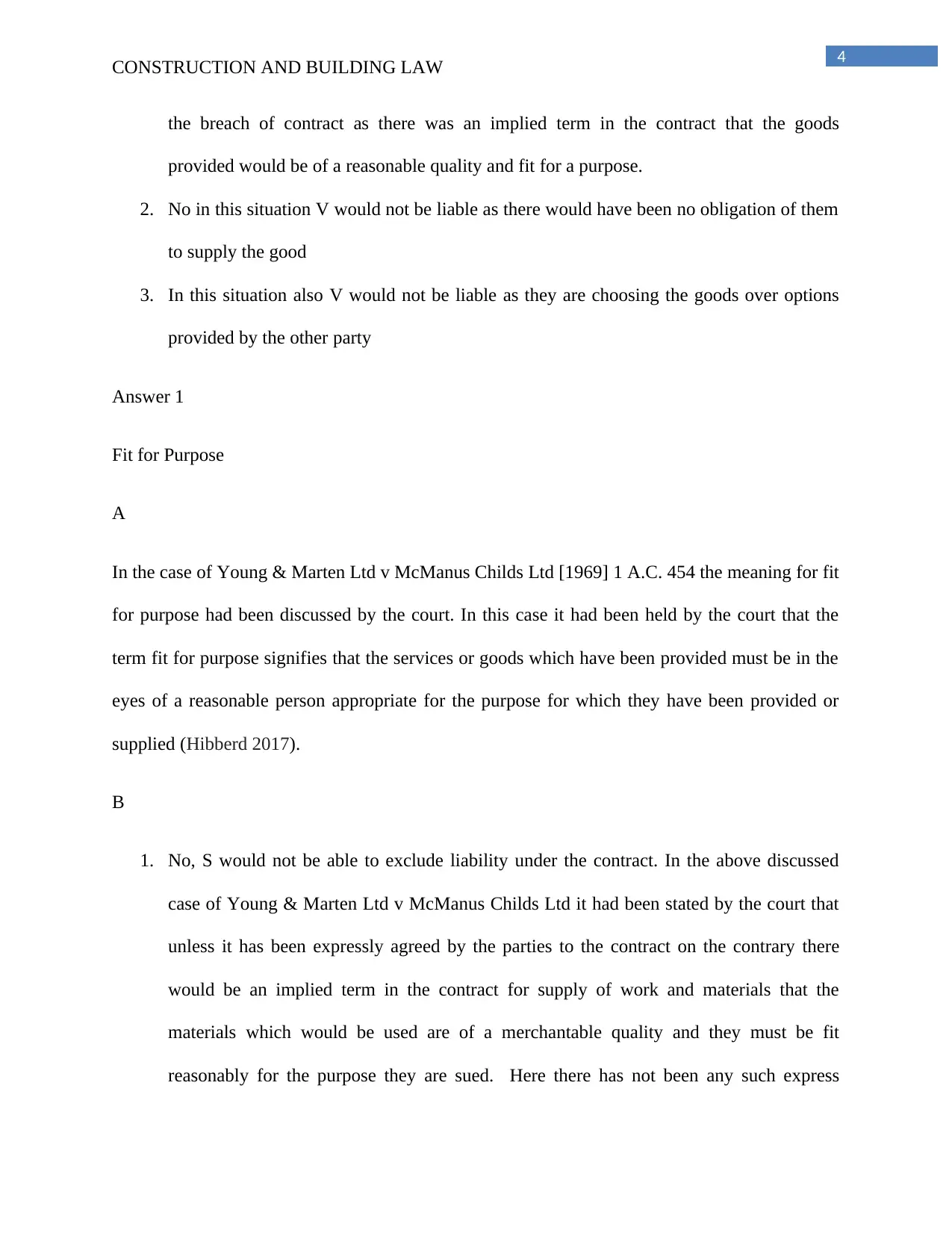
4
CONSTRUCTION AND BUILDING LAW
the breach of contract as there was an implied term in the contract that the goods
provided would be of a reasonable quality and fit for a purpose.
2. No in this situation V would not be liable as there would have been no obligation of them
to supply the good
3. In this situation also V would not be liable as they are choosing the goods over options
provided by the other party
Answer 1
Fit for Purpose
A
In the case of Young & Marten Ltd v McManus Childs Ltd [1969] 1 A.C. 454 the meaning for fit
for purpose had been discussed by the court. In this case it had been held by the court that the
term fit for purpose signifies that the services or goods which have been provided must be in the
eyes of a reasonable person appropriate for the purpose for which they have been provided or
supplied (Hibberd 2017).
B
1. No, S would not be able to exclude liability under the contract. In the above discussed
case of Young & Marten Ltd v McManus Childs Ltd it had been stated by the court that
unless it has been expressly agreed by the parties to the contract on the contrary there
would be an implied term in the contract for supply of work and materials that the
materials which would be used are of a merchantable quality and they must be fit
reasonably for the purpose they are sued. Here there has not been any such express
CONSTRUCTION AND BUILDING LAW
the breach of contract as there was an implied term in the contract that the goods
provided would be of a reasonable quality and fit for a purpose.
2. No in this situation V would not be liable as there would have been no obligation of them
to supply the good
3. In this situation also V would not be liable as they are choosing the goods over options
provided by the other party
Answer 1
Fit for Purpose
A
In the case of Young & Marten Ltd v McManus Childs Ltd [1969] 1 A.C. 454 the meaning for fit
for purpose had been discussed by the court. In this case it had been held by the court that the
term fit for purpose signifies that the services or goods which have been provided must be in the
eyes of a reasonable person appropriate for the purpose for which they have been provided or
supplied (Hibberd 2017).
B
1. No, S would not be able to exclude liability under the contract. In the above discussed
case of Young & Marten Ltd v McManus Childs Ltd it had been stated by the court that
unless it has been expressly agreed by the parties to the contract on the contrary there
would be an implied term in the contract for supply of work and materials that the
materials which would be used are of a merchantable quality and they must be fit
reasonably for the purpose they are sued. Here there has not been any such express

5
CONSTRUCTION AND BUILDING LAW
agreement and thus it can be stated that it is an implied term for S to supply tiles with are
of merchantable quality and fit for the purpose.
2. Yes in this situation S would not be liable as there would have been no obligation of
them to supply the good
3. In this situation also S would not be liable as they are choosing the goods over options
provided by the employer
Answer 2
“variations” and the common method for “valuing variations”
A
A variation which is also called a variation order or a variation instruction is a alternation to the
scope of work in relation to construction contracts which takes place like an addition,
substitution and omission form the originally provided work. One of the most common way of
valuing variation is by using rates derived from a breakdown of the contract sum. Under this
methods the changes would be valued by the use of pricing information which is directly
associated with the incurring of the contract sum. For instance use of rates in bill of quantities.
B
1. No, V would not be able to exclude liability under the contract. In the above discussed
case of Young & Marten Ltd v McManus Childs Ltd it had been stated by the court that
unless it has been expressly agreed by the parties to the contract on the contrary there
would be an implied term in the contract for supply of work and materials that the
materials which would be used are of a merchantable quality and they must be fit
CONSTRUCTION AND BUILDING LAW
agreement and thus it can be stated that it is an implied term for S to supply tiles with are
of merchantable quality and fit for the purpose.
2. Yes in this situation S would not be liable as there would have been no obligation of
them to supply the good
3. In this situation also S would not be liable as they are choosing the goods over options
provided by the employer
Answer 2
“variations” and the common method for “valuing variations”
A
A variation which is also called a variation order or a variation instruction is a alternation to the
scope of work in relation to construction contracts which takes place like an addition,
substitution and omission form the originally provided work. One of the most common way of
valuing variation is by using rates derived from a breakdown of the contract sum. Under this
methods the changes would be valued by the use of pricing information which is directly
associated with the incurring of the contract sum. For instance use of rates in bill of quantities.
B
1. No, V would not be able to exclude liability under the contract. In the above discussed
case of Young & Marten Ltd v McManus Childs Ltd it had been stated by the court that
unless it has been expressly agreed by the parties to the contract on the contrary there
would be an implied term in the contract for supply of work and materials that the
materials which would be used are of a merchantable quality and they must be fit
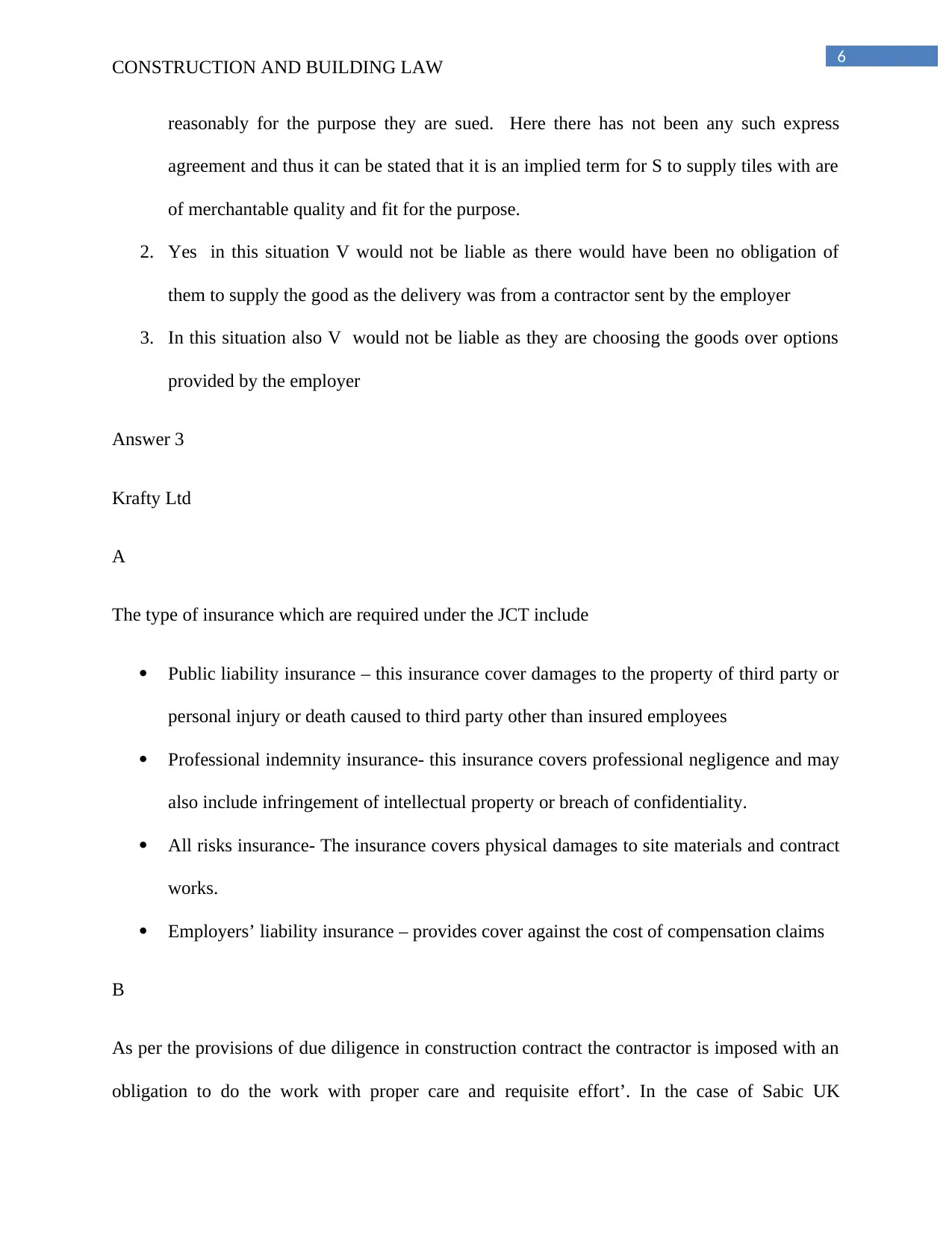
6
CONSTRUCTION AND BUILDING LAW
reasonably for the purpose they are sued. Here there has not been any such express
agreement and thus it can be stated that it is an implied term for S to supply tiles with are
of merchantable quality and fit for the purpose.
2. Yes in this situation V would not be liable as there would have been no obligation of
them to supply the good as the delivery was from a contractor sent by the employer
3. In this situation also V would not be liable as they are choosing the goods over options
provided by the employer
Answer 3
Krafty Ltd
A
The type of insurance which are required under the JCT include
Public liability insurance – this insurance cover damages to the property of third party or
personal injury or death caused to third party other than insured employees
Professional indemnity insurance- this insurance covers professional negligence and may
also include infringement of intellectual property or breach of confidentiality.
All risks insurance- The insurance covers physical damages to site materials and contract
works.
Employers’ liability insurance – provides cover against the cost of compensation claims
B
As per the provisions of due diligence in construction contract the contractor is imposed with an
obligation to do the work with proper care and requisite effort’. In the case of Sabic UK
CONSTRUCTION AND BUILDING LAW
reasonably for the purpose they are sued. Here there has not been any such express
agreement and thus it can be stated that it is an implied term for S to supply tiles with are
of merchantable quality and fit for the purpose.
2. Yes in this situation V would not be liable as there would have been no obligation of
them to supply the good as the delivery was from a contractor sent by the employer
3. In this situation also V would not be liable as they are choosing the goods over options
provided by the employer
Answer 3
Krafty Ltd
A
The type of insurance which are required under the JCT include
Public liability insurance – this insurance cover damages to the property of third party or
personal injury or death caused to third party other than insured employees
Professional indemnity insurance- this insurance covers professional negligence and may
also include infringement of intellectual property or breach of confidentiality.
All risks insurance- The insurance covers physical damages to site materials and contract
works.
Employers’ liability insurance – provides cover against the cost of compensation claims
B
As per the provisions of due diligence in construction contract the contractor is imposed with an
obligation to do the work with proper care and requisite effort’. In the case of Sabic UK
Paraphrase This Document
Need a fresh take? Get an instant paraphrase of this document with our AI Paraphraser
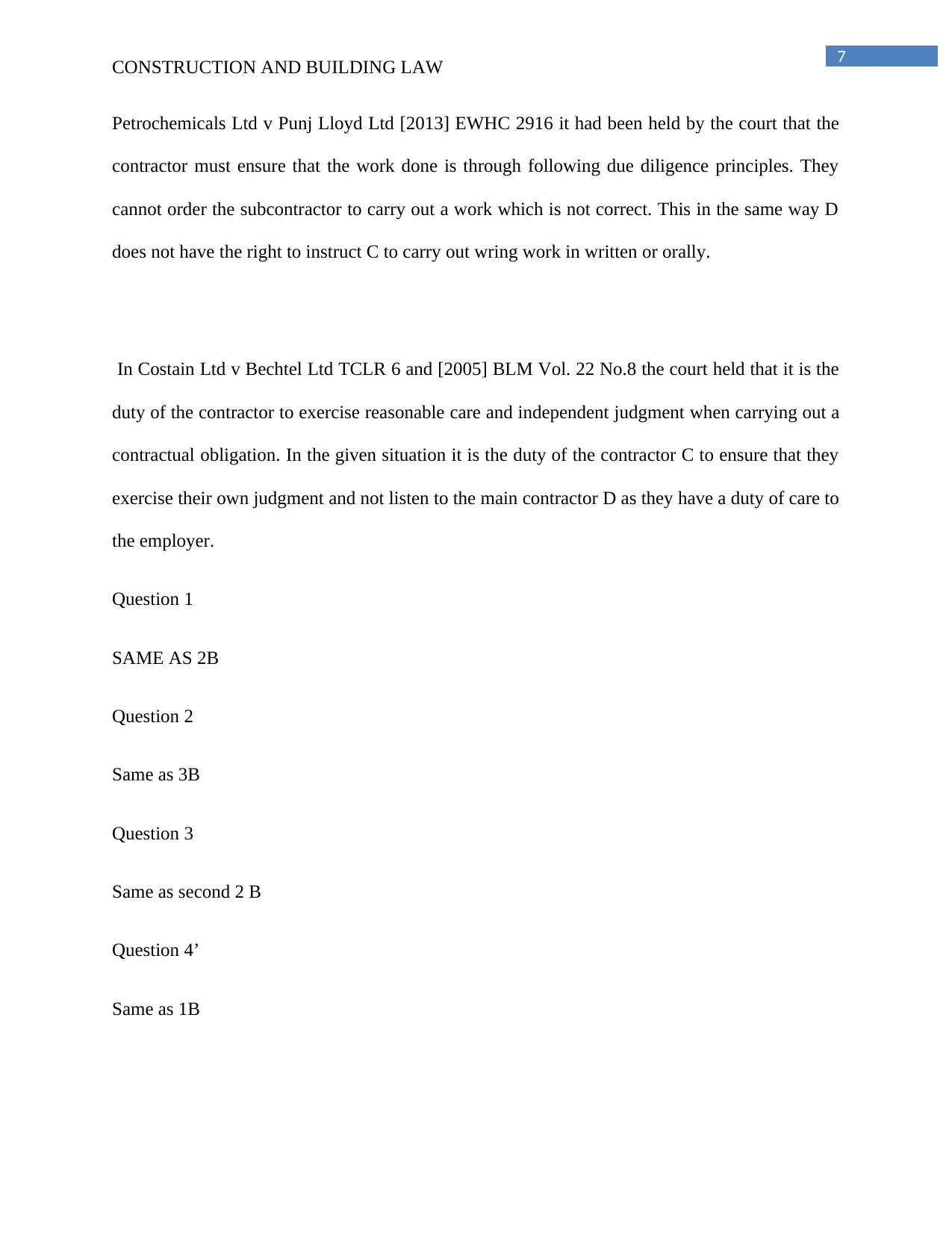
7
CONSTRUCTION AND BUILDING LAW
Petrochemicals Ltd v Punj Lloyd Ltd [2013] EWHC 2916 it had been held by the court that the
contractor must ensure that the work done is through following due diligence principles. They
cannot order the subcontractor to carry out a work which is not correct. This in the same way D
does not have the right to instruct C to carry out wring work in written or orally.
In Costain Ltd v Bechtel Ltd TCLR 6 and [2005] BLM Vol. 22 No.8 the court held that it is the
duty of the contractor to exercise reasonable care and independent judgment when carrying out a
contractual obligation. In the given situation it is the duty of the contractor C to ensure that they
exercise their own judgment and not listen to the main contractor D as they have a duty of care to
the employer.
Question 1
SAME AS 2B
Question 2
Same as 3B
Question 3
Same as second 2 B
Question 4’
Same as 1B
CONSTRUCTION AND BUILDING LAW
Petrochemicals Ltd v Punj Lloyd Ltd [2013] EWHC 2916 it had been held by the court that the
contractor must ensure that the work done is through following due diligence principles. They
cannot order the subcontractor to carry out a work which is not correct. This in the same way D
does not have the right to instruct C to carry out wring work in written or orally.
In Costain Ltd v Bechtel Ltd TCLR 6 and [2005] BLM Vol. 22 No.8 the court held that it is the
duty of the contractor to exercise reasonable care and independent judgment when carrying out a
contractual obligation. In the given situation it is the duty of the contractor C to ensure that they
exercise their own judgment and not listen to the main contractor D as they have a duty of care to
the employer.
Question 1
SAME AS 2B
Question 2
Same as 3B
Question 3
Same as second 2 B
Question 4’
Same as 1B
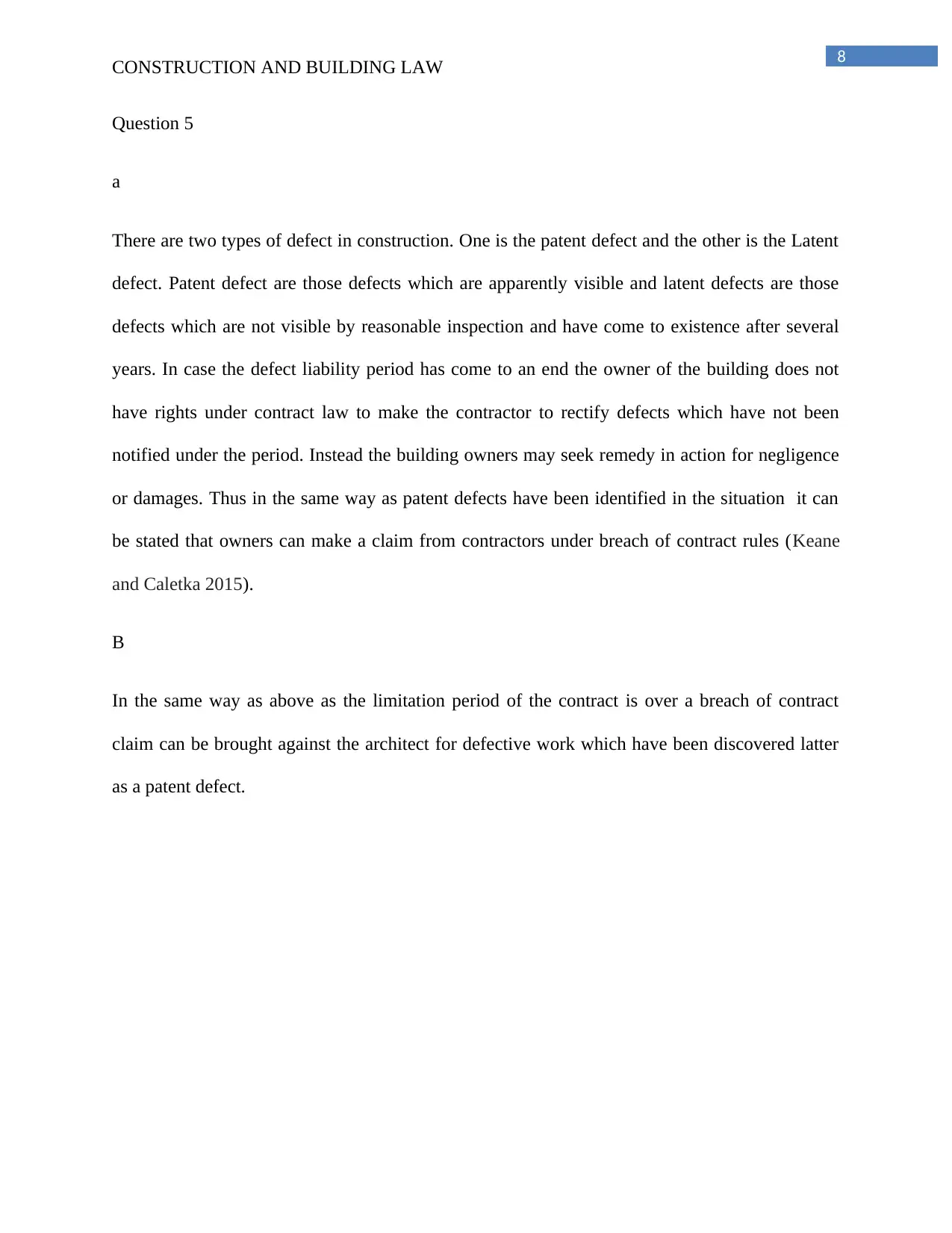
8
CONSTRUCTION AND BUILDING LAW
Question 5
a
There are two types of defect in construction. One is the patent defect and the other is the Latent
defect. Patent defect are those defects which are apparently visible and latent defects are those
defects which are not visible by reasonable inspection and have come to existence after several
years. In case the defect liability period has come to an end the owner of the building does not
have rights under contract law to make the contractor to rectify defects which have not been
notified under the period. Instead the building owners may seek remedy in action for negligence
or damages. Thus in the same way as patent defects have been identified in the situation it can
be stated that owners can make a claim from contractors under breach of contract rules (Keane
and Caletka 2015).
B
In the same way as above as the limitation period of the contract is over a breach of contract
claim can be brought against the architect for defective work which have been discovered latter
as a patent defect.
CONSTRUCTION AND BUILDING LAW
Question 5
a
There are two types of defect in construction. One is the patent defect and the other is the Latent
defect. Patent defect are those defects which are apparently visible and latent defects are those
defects which are not visible by reasonable inspection and have come to existence after several
years. In case the defect liability period has come to an end the owner of the building does not
have rights under contract law to make the contractor to rectify defects which have not been
notified under the period. Instead the building owners may seek remedy in action for negligence
or damages. Thus in the same way as patent defects have been identified in the situation it can
be stated that owners can make a claim from contractors under breach of contract rules (Keane
and Caletka 2015).
B
In the same way as above as the limitation period of the contract is over a breach of contract
claim can be brought against the architect for defective work which have been discovered latter
as a patent defect.
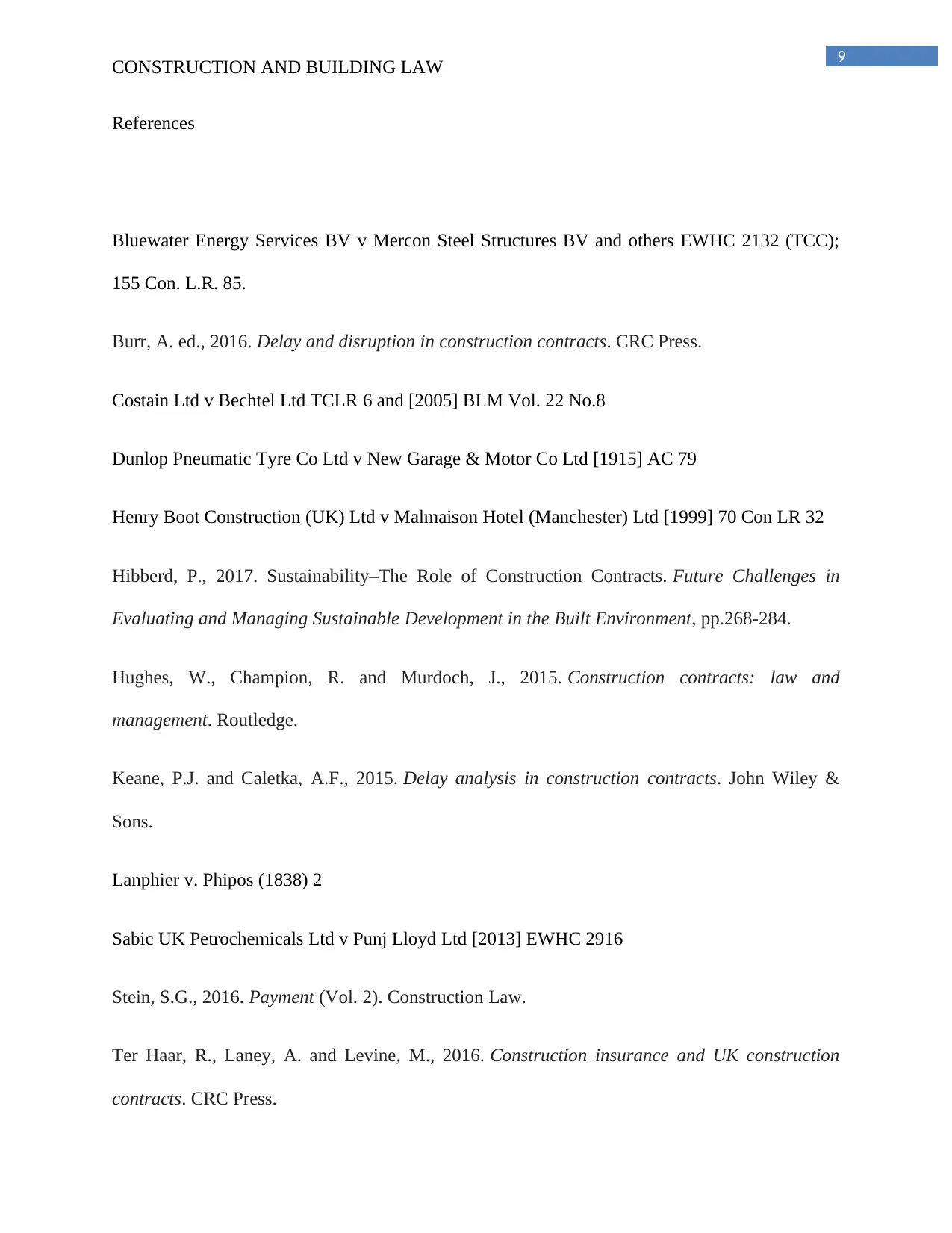
9
CONSTRUCTION AND BUILDING LAW
References
Bluewater Energy Services BV v Mercon Steel Structures BV and others EWHC 2132 (TCC);
155 Con. L.R. 85.
Burr, A. ed., 2016. Delay and disruption in construction contracts. CRC Press.
Costain Ltd v Bechtel Ltd TCLR 6 and [2005] BLM Vol. 22 No.8
Dunlop Pneumatic Tyre Co Ltd v New Garage & Motor Co Ltd [1915] AC 79
Henry Boot Construction (UK) Ltd v Malmaison Hotel (Manchester) Ltd [1999] 70 Con LR 32
Hibberd, P., 2017. Sustainability–The Role of Construction Contracts. Future Challenges in
Evaluating and Managing Sustainable Development in the Built Environment, pp.268-284.
Hughes, W., Champion, R. and Murdoch, J., 2015. Construction contracts: law and
management. Routledge.
Keane, P.J. and Caletka, A.F., 2015. Delay analysis in construction contracts. John Wiley &
Sons.
Lanphier v. Phipos (1838) 2
Sabic UK Petrochemicals Ltd v Punj Lloyd Ltd [2013] EWHC 2916
Stein, S.G., 2016. Payment (Vol. 2). Construction Law.
Ter Haar, R., Laney, A. and Levine, M., 2016. Construction insurance and UK construction
contracts. CRC Press.
CONSTRUCTION AND BUILDING LAW
References
Bluewater Energy Services BV v Mercon Steel Structures BV and others EWHC 2132 (TCC);
155 Con. L.R. 85.
Burr, A. ed., 2016. Delay and disruption in construction contracts. CRC Press.
Costain Ltd v Bechtel Ltd TCLR 6 and [2005] BLM Vol. 22 No.8
Dunlop Pneumatic Tyre Co Ltd v New Garage & Motor Co Ltd [1915] AC 79
Henry Boot Construction (UK) Ltd v Malmaison Hotel (Manchester) Ltd [1999] 70 Con LR 32
Hibberd, P., 2017. Sustainability–The Role of Construction Contracts. Future Challenges in
Evaluating and Managing Sustainable Development in the Built Environment, pp.268-284.
Hughes, W., Champion, R. and Murdoch, J., 2015. Construction contracts: law and
management. Routledge.
Keane, P.J. and Caletka, A.F., 2015. Delay analysis in construction contracts. John Wiley &
Sons.
Lanphier v. Phipos (1838) 2
Sabic UK Petrochemicals Ltd v Punj Lloyd Ltd [2013] EWHC 2916
Stein, S.G., 2016. Payment (Vol. 2). Construction Law.
Ter Haar, R., Laney, A. and Levine, M., 2016. Construction insurance and UK construction
contracts. CRC Press.
Secure Best Marks with AI Grader
Need help grading? Try our AI Grader for instant feedback on your assignments.
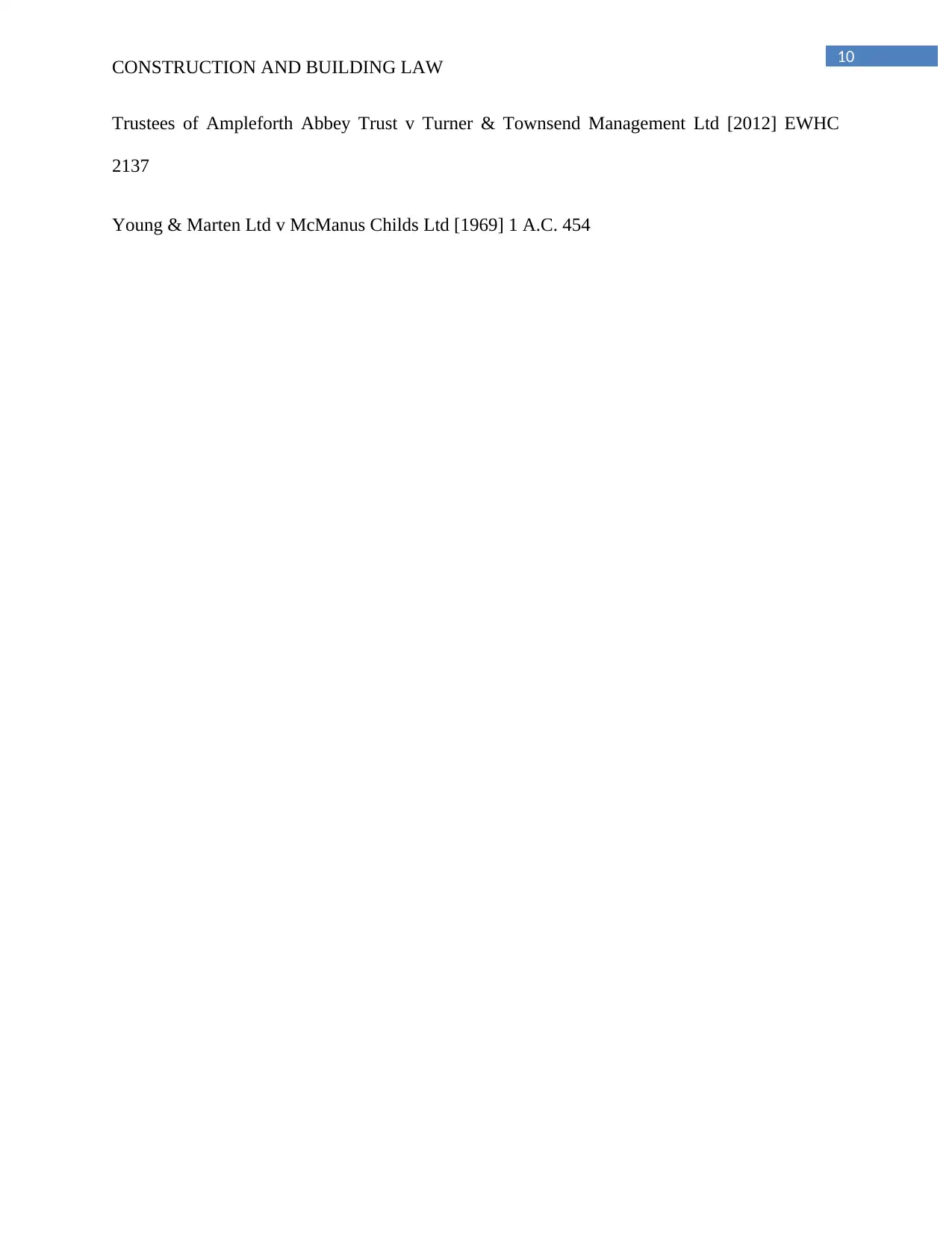
10
CONSTRUCTION AND BUILDING LAW
Trustees of Ampleforth Abbey Trust v Turner & Townsend Management Ltd [2012] EWHC
2137
Young & Marten Ltd v McManus Childs Ltd [1969] 1 A.C. 454
CONSTRUCTION AND BUILDING LAW
Trustees of Ampleforth Abbey Trust v Turner & Townsend Management Ltd [2012] EWHC
2137
Young & Marten Ltd v McManus Childs Ltd [1969] 1 A.C. 454
1 out of 11
Your All-in-One AI-Powered Toolkit for Academic Success.
+13062052269
info@desklib.com
Available 24*7 on WhatsApp / Email
![[object Object]](/_next/static/media/star-bottom.7253800d.svg)
Unlock your academic potential
© 2024 | Zucol Services PVT LTD | All rights reserved.





